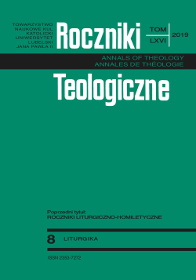Liturgical Texts in Honor of the Saint Three Kings
Abstract
This article is about showing the reader a very small passage of a much broader topic: Liturgy for travelers, pilgrims and sailing on the sea. Based on the research, it turned out that the Church, as evidenced by the first written liturgical sources, i.e. the sacramentaries and then especially, at the height of the Middle Ages, the pontificals, the missals and the rituals, took care of these people by preparing appropriate liturgical texts. Mass forms should be listed here: Pro iter agentibus, Pro peregrinantibus and Pro navigantibus. This is the first group. The second group is the rite of blessing of people going on a trip or on pilgrimage (Ordo ad servicium peregrinorum faciendum) or their travel equipment, such as a bag, a walking stick, a cross and a cloak (Benedictio ad baculum et ad peram) and the rituals of returning from pilgrimage or travel (Benedictio peregrinorum post reditum). In the post-Conciliar liturgy, few formulas of this wealth of prayers remain in use.
A separate and very interesting chapter are liturgical texts that are associated with the patronage of some saints, such as Saint James the Elder, Saint Raphael Archangel, Saint Julian, Saint Christopher, and Saint Three Kings. In the case of the Saint Three Kings, who were considered in the Middle Ages as patrons of travelers and pilgrims, and whose relics in the Cologne Cathedral attracted both newly crowned kings and crowds of other pilgrims from all over Europe, they were considered the first pilgrims of the Christian age who made pilgrimage to the newborn Jesus Christ. It is puzzling that the Mass forms (because the rites of blessing are unknown) can be classified into four distinct groups. Across Europe—from England to Germany and Poland—they can be found in many medieval missals, but not in Cologne missals.
This article presents only the first Mass form De tribus magis pro iter agentibus. Mass orations develop the theme of the mags’ path from the East to Bethlehem to bow to the Messiah, whose special star came up in the sky and led them to Him, so that they could celebrate Him with mystical gifts. The Church prays for own faithful on their pilgrimage that through these saints and through their merits the pilgrims would abound in peace, health and prosperity. May Christ Himself, called the true Sun, Star and Light, lead them unscathed to the desired sanctuary. Further, the Church asks God to send pilgrims an Angel of Peace as a companion on the road, guarding them against the dangers of the body and soul and against the attacks of the old enemy, i.e. Satan, and that they become worthy of the Holy Spirit’s company. Another thought raised in euchology is the history of the Son of God (incarnation, passion and resurrection) and the role of angels as his witnesses, which is to express in the care of pilgrims day and night. The first Bible reading (Gen 24:7) is about Abraham’s journey to his homeland and the promise of an Angel as a companion on the road. On the other hand, the Gospel pericope (Lk 4:23b-30) is a conversation between the Pharisees and Jesus, who is not welcomed in his homeland. During this conversation, the tension between the homeland and the exile, between the stranger and the own plays an important role. For this reason, the pericope was probably chosen for the Mass form. Mass antiphons (introitus, graduale, offertorium and communio) have fragments of Psalms as their source and take up typical motifs for the discussed subject: God leading on the road, the company of angels on the road, trust in God and rescue in God. The sequence Maiestati sacrosantae militans, which was sometimes attached to this form, will be discussed in a separate article.
References
Die Heiligen Drei Könige – Darstellung und Verehrung. Katalog zur Ausstellung des Wallraf-Richartz-Museums in der Josef-Haubrich-Kunsthalle Köln (1. Dez. 1982 bis 30. Jan. 1983), Köln 1982, 16-19.
Flinspach, Karl-Heinz, und Annette Heusch-Altenstein. Jakobswege. Wege der Jakobspilger im Rheinland, Bd. 1. Köln: J.P. Bachem Verlag, 2001.
Franz, Adolph. Die Messe im deutschen Mittelalter. Freiburg: Herder, 1902.
Schauber, Vera, und Hanns Michael Schindler (Hgg.). Bildlexikon der Heiligen, Seligen und Namenspatrone. Augsburg: Pattloch, 1999.
Torsy, Jakob. Achthundert Jahre Verehrung der Heiligen Drei Könige in Köln 1164-1964 (= Kölner Domblatt 23/24). Köln: J.P. Bachem Verlag, 1964.
Copyright (c) 2019 Roczniki Teologiczne

This work is licensed under a Creative Commons Attribution-NonCommercial-NoDerivatives 4.0 International License.





